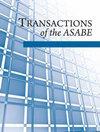Modeling Evapotranspiration of Winter Wheat Using Contextual and Pixel-Based Surface Energy Balance Models
IF 1.4
4区 农林科学
Q3 AGRICULTURAL ENGINEERING
引用次数: 4
Abstract
Highlights Three contextual-based (CB) and two pixel-based (PB) models were evaluated to estimate ET of rainfed winter wheat. Instantaneous available energy estimation and ET upscaling impacted model performance. The CB models performed better at instantaneous and daily scales compared to the PB models. ET estimation biases increased during low vegetation and drier conditions, especially for the PB models. Abstract. Surface energy balance (SEB) models based on thermal remote sensing data are widely used in research applications to map evapotranspiration (ET) across various landscapes. However, their ability to capture ET from winter wheat remains underexplored, especially in practical applications such as integrated resource management and drought preparedness. Investigating winter wheat ET dynamics is important in agricultural regions such as the Southern Great Plains of the U.S., where winter wheat is extensively cultivated. The goal of this study was to evaluate the performance of five fully automated SEB models, three contextual-based (CB) and two pixel-based (PB), in estimating instantaneous and daily ET of winter wheat by comparing the model results with flux tower observations. The CB models included Surface Energy Balance Algorithm for Land (SEBAL), Mapping Evapotranspiration at high Resolution with Internalized Calibration (METRIC), and Triangular Vegetation Temperature (TVT). The PB models included Surface Energy Balance System (SEBS) and Two-Source Energy Balance (TSEB). Model evaluation during two winter wheat growing seasons (2016-2018) using 28 Landsat images showed that the instantaneous ET estimates from METRIC and TSEB had the smallest (RMSE = 0.14 mm h-1) and largest (RMSE = 0.27 mm h-1) errors, respectively. At the daily scale, SEBAL was the best performing model (RMSE = 1.0 mm d-1), followed by TVT (RMSE = 1.1 mm d-1), METRIC (RMSE = 1.2 mm d-1), SEBS (RMSE = 1.3 mm d-1), and TSEB (RMSE = 1.5 mm d-1). Overall, the CB models provided smaller errors than the PB models. Larger errors in daily ET estimation were observed during low vegetation and drier conditions, especially for the PB models.基于上下文和基于像素的地表能量平衡模型模拟冬小麦蒸散发
利用3种基于情景的(CB)模型和2种基于像元的(PB)模型估算了旱作冬小麦的蒸散发。瞬时可用能量估计和ET上尺度影响模型性能。与PB模型相比,CB模型在瞬时尺度和日尺度上表现较好。在低植被和干旱条件下,ET估算偏差增大,特别是PB模式。摘要基于热遥感数据的地表能量平衡(SEB)模型被广泛用于研究不同景观的蒸散发(ET)。然而,它们从冬小麦中捕获ET的能力仍未得到充分探索,特别是在综合资源管理和抗旱准备等实际应用中。在美国南部大平原等广泛种植冬小麦的农业地区,研究冬小麦的ET动态是很重要的。本研究的目的是通过将模型结果与通量塔观测结果进行比较,评估5个全自动SEB模型(3个基于情境(CB)和2个基于像素(PB))在估算冬小麦瞬时和日蒸散方面的性能。CB模型包括陆地表面能量平衡算法(SEBAL)、基于内化定标的高分辨率蒸散发映射(METRIC)和三角形植被温度(TVT)。PB模型包括表面能量平衡系统(SEBS)和双源能量平衡系统(TSEB)。利用28幅Landsat影像对两个冬小麦生长期(2016-2018)的模型进行评估,结果表明,METRIC和TSEB估算的瞬时ET分别具有最小(RMSE = 0.14 mm h-1)和最大(RMSE = 0.27 mm h-1)误差。在日尺度上,SEBAL模型表现最佳(RMSE = 1.0 mm d-1),其次是TVT (RMSE = 1.1 mm d-1)、METRIC (RMSE = 1.2 mm d-1)、SEBS (RMSE = 1.3 mm d-1)和TSEB (RMSE = 1.5 mm d-1)。总体而言,CB模型提供的误差小于PB模型。低植被和干旱条件下的日蒸散发估算误差较大,特别是PB模式。
本文章由计算机程序翻译,如有差异,请以英文原文为准。
求助全文
约1分钟内获得全文
求助全文
来源期刊

Transactions of the ASABE
AGRICULTURAL ENGINEERING-
CiteScore
2.30
自引率
0.00%
发文量
0
审稿时长
6 months
期刊介绍:
This peer-reviewed journal publishes research that advances the engineering of agricultural, food, and biological systems. Submissions must include original data, analysis or design, or synthesis of existing information; research information for the improvement of education, design, construction, or manufacturing practice; or significant and convincing evidence that confirms and strengthens the findings of others or that revises ideas or challenges accepted theory.
 求助内容:
求助内容: 应助结果提醒方式:
应助结果提醒方式:


